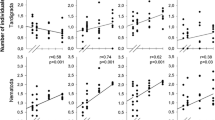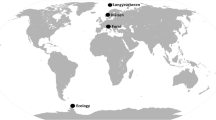Abstract
I studied the effect of treehole (microhabitat) size distribution in local habitats on geographic difference in aquatic metazoan community structure by comparing differences between two sites on Iriomote Island, and between Iriomote Island (subtropical) and Tsushima Island (temperate), in southwestern Japan. In treeholes at each local site, the amount of litter, the species richness and total biomass of metazoa were positively correlated with treehole capacity. Between the two sites on Iriomote Island (Shirahama and Komi), the amount of litter, biomass and species number per treehole was greater at Komi where the mean and variance of treehole size were greater, while the dependencies of these parameters on treehole capacity were common to both sites. Total species number was larger at Komi (2 predators and 20 saprophages) than at Shirahama (1 predator and 19 saprophages). Most of the dominant taxa colonized larger treeholes with higher probabilities, although one taxa showed the opposite trend. Treeholes on Tsushima were smaller than those on Iriomote. The metazoan fauna in treeholes consisted of 15 saprophages on Tsushima, being less richer than that on Iriomote Island which had 2 predators and 21 saprophages. However, the dependencies of litter amount and biomass on treehole capacity did not differ significantly between the islands, although treeholes on Iriomote harbored a greater number of species per treehole than those on Tsushima. This study indicated that there are general correlates between community structure within individual treeholes (infracommunity structure) and treehole capacity (microhabitat size). Therefore, microhabitat-size distribution is potentially a significant constraint of local community structure, and its variation may contribute to the variation in local and regional species richness.
Similar content being viewed by others
References
Aho, A. M. and A. O. Bush (1993) Community richness in parasites of some freshwater fishes from North America, pp. 185–193. In R. E. Ricklefs and D. Schluter (eds.)Species diversity in ecological communites: Historical and geographical perspectives. The University of Chicago Press, Chicago.
Cornell, H. V. and J. H. Lawton (1992) Species interactions, local and regional processes, and limits to the richness of ecological communities: a theoretical perspective.Journal of Animal Ecology 61: 1–12.
Japan Meterological Agency (1991)Climatic table of Japan. Vol. 1. Japan Meterological Agency, Tokyo.
Jenkins, B., R. L. Kitching and S. L. Pimm (1992) Productivity, disturbance and food web structure at a local spatial scale in experimental container habitats.Oikos 65: 249–255.
Kitching, R. L. and S. L. Pimm (1985) The length of food chains: phytotelmata in Australia and elsewhere.Proceedings of the Ecological Society of Australia 14: 123–139.
Ricklefs, R. E. and D. Schluter (1993)Species diversity in ecological communites: Historical and geographical perspectives. The University of Chicago Press, Chicago.
Saito, H. (1981) Materials for the studies of litterfall in forest stands.Report of Experimental Forest of Kyoto Prefectural University 25: 78–89.
Shoener, T. W. (1989) Food webs from the small to the large.Ecology 70: 1559–1589.
Sota, T. (1996) Effects of capacity on resource input and the aquatic metazoan community structure in phytotelmata.Researches on Population Ecology 38: 65–73.
Sota, T., M. Mogi and E. Hayamizu (1994) Habitat stability and the larval mosquito community in treeholes and other containers on a temperate island.Researches on Population Ecology 36: 93–104.
Sota, T., M. Mogi and K. Kato (1998) Local- and regional-scale food web structure inNepenthes alata pitchers.Biotropica 30: 82–91.
Spencer, M. and P. H. Warren (1996a) The effects of habitat size and productivity on food web structure in small aquatic microcosms.Oikos 75: 419–430.
Spencer, M. and P. H. Warren (1996b) The effects of energy input, immigration and habitat size on food web structure: a microcosm experiment.Oecologia 108: 764–770.
Wright, D. H. (1983) Species-energy theory: an extension of speciesarea theory.Oikos 41: 496–506.
Author information
Authors and Affiliations
Corresponding author
Rights and permissions
About this article
Cite this article
Sota, T. Microhabitat size distribution affects local difference in community structure: Metazoan communities in treeholes. Res Popul Ecol 40, 249–255 (1998). https://doi.org/10.1007/BF02763411
Received:
Accepted:
Issue Date:
DOI: https://doi.org/10.1007/BF02763411




